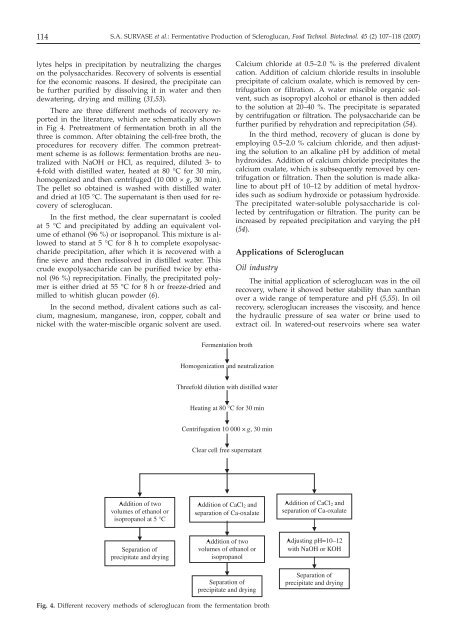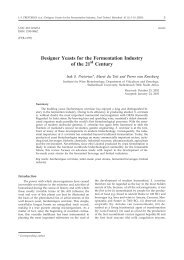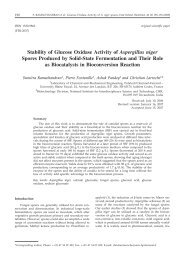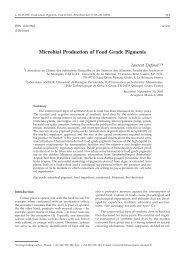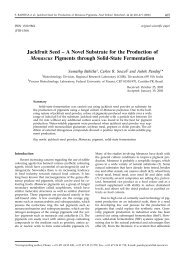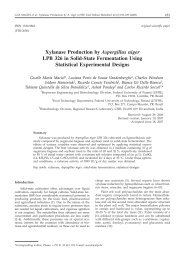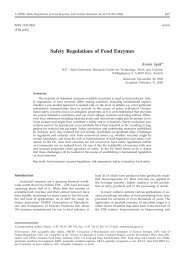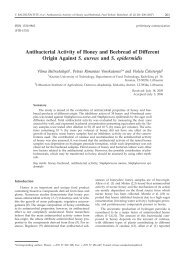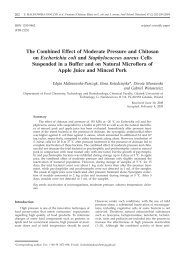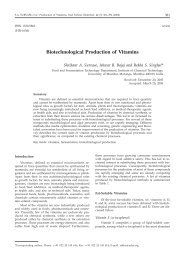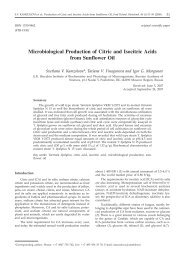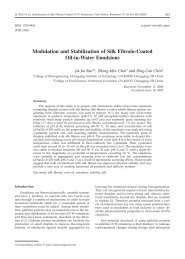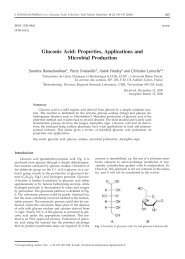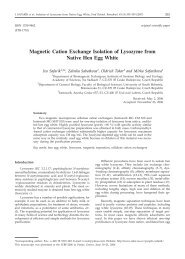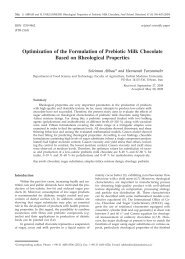Scleroglucan - Food Technology and Biotechnology
Scleroglucan - Food Technology and Biotechnology
Scleroglucan - Food Technology and Biotechnology
Create successful ePaper yourself
Turn your PDF publications into a flip-book with our unique Google optimized e-Paper software.
114 S.A. SURVASE et al.: Fermentative Production of <strong>Scleroglucan</strong>, <strong>Food</strong> Technol. Biotechnol. 45 (2) 107–118 (2007)<br />
lytes helps in precipitation by neutralizing the charges<br />
on the polysaccharides. Recovery of solvents is essential<br />
for the economic reasons. If desired, the precipitate can<br />
be further purified by dissolving it in water <strong>and</strong> then<br />
dewatering, drying <strong>and</strong> milling (31,53).<br />
There are three different methods of recovery reported<br />
in the literature, which are schematically shown<br />
in Fig 4. Pretreatment of fermentation broth in all the<br />
three is common. After obtaining the cell-free broth, the<br />
procedures for recovery differ. The common pretreatment<br />
scheme is as follows: fermentation broths are neutralized<br />
with NaOH or HCl, as required, diluted 3- to<br />
4-fold with distilled water, heated at 80 °C for 30 min,<br />
homogenized <strong>and</strong> then centrifuged (10 000 × g, 30min).<br />
The pellet so obtained is washed with distilled water<br />
<strong>and</strong> dried at 105 °C. The supernatant is then used for recovery<br />
of scleroglucan.<br />
In the first method, the clear supernatant is cooled<br />
at 5 °C <strong>and</strong> precipitated by adding an equivalent volume<br />
of ethanol (96 %) or isopropanol. This mixture is allowedtost<strong>and</strong>at5°Cfor8htocomplete<br />
exopolysaccharide<br />
precipitation, after which it is recovered with a<br />
fine sieve <strong>and</strong> then redissolved in distilled water. This<br />
crude exopolysaccharide can be purified twice by ethanol<br />
(96 %) reprecipitation. Finally, the precipitated polymer<br />
is either dried at 55 °C for 8 h or freeze-dried <strong>and</strong><br />
milled to whitish glucan powder (6).<br />
In the second method, divalent cations such as calcium,<br />
magnesium, manganese, iron, copper, cobalt <strong>and</strong><br />
nickel with the water-miscible organic solvent are used.<br />
Calcium chloride at 0.5–2.0 % is the preferred divalent<br />
cation. Addition of calcium chloride results in insoluble<br />
precipitate of calcium oxalate, which is removed by centrifugation<br />
or filtration. A water miscible organic solvent,<br />
such as isopropyl alcohol or ethanol is then added<br />
to the solution at 20–40 %. The precipitate is separated<br />
by centrifugation or filtration. The polysaccharide can be<br />
further purified by rehydration <strong>and</strong> reprecipitation (54).<br />
In the third method, recovery of glucan is done by<br />
employing 0.5–2.0 % calcium chloride, <strong>and</strong> then adjusting<br />
the solution to an alkaline pH by addition of metal<br />
hydroxides. Addition of calcium chloride precipitates the<br />
calcium oxalate, which is subsequently removed by centrifugation<br />
or filtration. Then the solution is made alkaline<br />
to about pH of 10–12 by addition of metal hydroxides<br />
such as sodium hydroxide or potassium hydroxide.<br />
The precipitated water-soluble polysaccharide is collected<br />
by centrifugation or filtration. The purity can be<br />
increased by repeated precipitation <strong>and</strong> varying the pH<br />
(54).<br />
Applications of <strong>Scleroglucan</strong><br />
Oil industry<br />
The initial application of scleroglucan was in the oil<br />
recovery, where it showed better stability than xanthan<br />
over a wide range of temperature <strong>and</strong> pH (5,55). In oil<br />
recovery, scleroglucan increases the viscosity, <strong>and</strong> hence<br />
the hydraulic pressure of sea water or brine used to<br />
extract oil. In watered-out reservoirs where sea water<br />
<br />
<br />
<br />
<br />
g <br />
<br />
<br />
<br />
<br />
<br />
<br />
<br />
<br />
<br />
<br />
<br />
<br />
<br />
<br />
<br />
<br />
<br />
<br />
<br />
Fig. 4. Different recovery methods of scleroglucan from the fermentation broth


